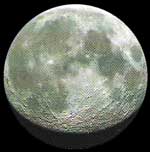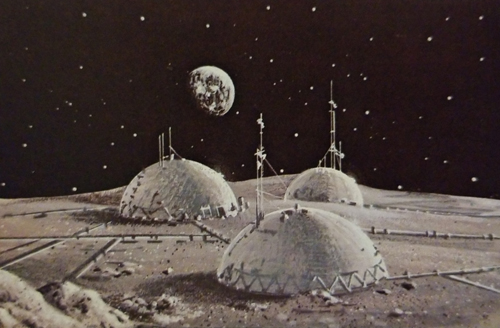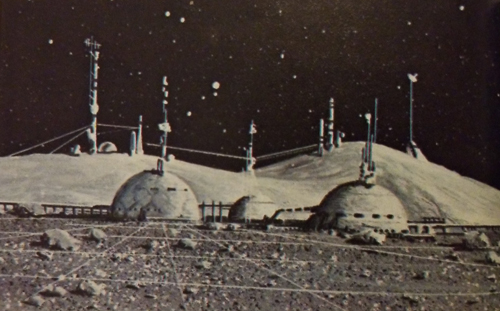Luna (FASA)
| Coordinates | 23.9, 61.8, 0.0[1] |
| Affiliation | United Federation of Planets |
| Planetary Class | J[2]
|
| Advertising |
|
Goddard Moonbase on Luna (Sol IIIa) (SFC)
The sole satellite of Earth,[3] Luna was a Class J world.[2] The first permanent base on the moon, jointly funded by the United States of America and Japan, was established on 18 April 1997. This marks the rededication of humanity to space exploration as part of the rebuilding following the Eugenics Wars.[4] Goddard Moonbase, the first large-scale international space project, was officially established the following year, and provided accommodations for 70 in the fields of space research and industry.[5] In 1999, several more lunar stations were opened by various nations and several private corporations. Armstrong Center, remaining the largest, became a small city of scientists, technicians, and support personnel, and already beginning to cater to a growing tourist trade.[4]
The Science Council of Luna declared itself independent of the governments of the United States of America and Japan on 1 January 2001, and requested status as a United Nations protectorate. The request was granted, forming the first interplanetary Human government.[4] The United Space Initiative, which focused and accelerated man's exploration of the Solar system for the benefit of all mankind, was signed in New York on 15 October 2003.[5] As part of the Initiative, the United Nations Space Force was created, and several installations for the service were constructed over the next three years, including a base on the moon..[6]
Farside Moonbase on Luna (Sol IIIa) (SFC)
In 2004, the first major expansion of the Goddard Moonbase occured. Also that year, Farside Moonbase began operations, specializing in radio telescope observations. The first child born in space was born a year later at Farside Moonbase to Radio Telescope Technician 1st Class Rita Ashworth and Dr. Weldon Ashworth of the Astro-Telemetry Section; the parents named their son Jules, after the famous science-fiction writer, Jules Verne, who first envisioned Human exploration of the moon. The event was heralded the world over as "a new generation of man has begun." Thomas Morrison, the first person to die on the moon, was buried in a simple grave marking the historic occasion in 2006. On the 50th anniversary of the first manned mission to the moon, all six original Apollo landing sites officially became protected historic landmarks.[5]
By the 23rd century, Luna was extensively populated[1] by citizens from across the United Federation of Planets,[2] and the underground city of Lunaport was the fifth largest in the Federation,[1] and was unsurpassed for recreational facilities, transportation systems, and lodging.[2] The Federation Aerospace Museum – Smithsonian Annex was located on the lunar surface, in the Sea of Tranquility. The site of the first manned lunar landing was preserved within its walls, maintained in zero-atmosphere for the protection and preservation of the centuries-old footprints and equipment. Also on display are the Space Shuttle Joshua, which performed the first rescue of personnel marooned in trans-lunar space, and the U.N.S.S. Icarus, the first vessel to make contact with Alpha Centauri and the civilization located there. By the early 24th century, a recent acquisition by the museum was the transporter room of the U.S.S. Moscow, the site of the first successful transport of a Human.[2]
Notes and References
- ↑ 1.0 1.1 1.2 Maynard, Jeff (Author). Star Trek Maps. Star Trek. Book. Bantam Books. August 1980.
- ↑ 2.0 2.1 2.2 2.3 2.4 Johnson, Shane. Star Trek: The Worlds of the Federation. Pocket Books, 1989.
- ↑ Roddenberry, Gene (Executive Producer). "The Cage". Star Trek, season 0, episode 0 (Production number 01). Directed by Robert Butler. Written by Gene Roddenberry. Released 1986. Desilu Productions. 1965.
- ↑ 4.0 4.1 4.2 Wheeler, Wm. John et al (Authors). Cadet's Orientation Sourcebook. Star Trek: The Role Playing Game. Book 2004A, Second Edition. Cover art by Rowena. Graphics and layout by Dana Knutson and Jordan Weisman. FASA Corporation. 1983.
- ↑ 5.0 5.1 5.2 Goldstein, Stan et al (Authors). Spaceflight Chronology. Star Trek. Book. Wallaby Books. 1980.
- ↑ Theisen, John A. (Author). Star Fleet Intelligence Manual: Agent's Orientation Sourcebook. Star Trek: The Role Playing Game. Book 2014B . Cover art by David R. Deitrick. Illustrations by Dana Knutson, Todd F. Marsh, and Jeff Laubenstein. FASA Corporation. 1987.




